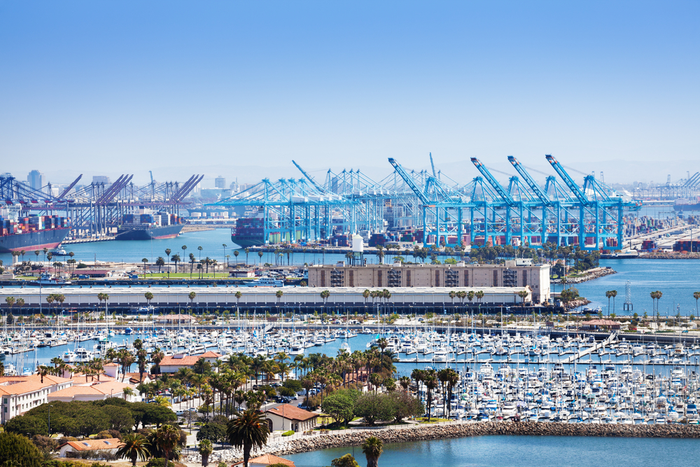
The ports of Los Angeles and Long Beach in July handled 53.7 percent of total US containerized imports, up 3.3 percentage points from 50.4 percent in July 2019. Photo credit: Shutterstock.com.
The surge of imports through the ports of Los Angeles and Long Beach that began in July and is projected to continue at least through September has interrupted a long-running shift in market share from US West Coast ports to East and Gulf coast gateways.
While imports were surging at the Southern California port complex, the largest East Coast gateways registered year-over-year volume declines in July, although port directors tell JOC.com their bookings for August were stronger than in July.
Speed-to-market for e-commerce fulfillment and personal protective equipment (PPE), and cheaper all-in costs compared with air freight, are driving much of the increased volume to Southern California. “It’s not the carriers that are directing this demand,” an executive at a large container line told JOC.com Monday. “We’re just providing the capacity.”
Carriers and forwarders have told JOC.com they expect these market forces to keep the Southern California port complex as the main gateway for US imports from Asia through the peak season.
Combined, Los Angeles and Long Beach in July handled 53.7 percent of total US containerized imports, up 3.3 percentage points from 50.4 percent in July 2019, according to PIERS, a JOC.com sister company within IHS Markit. The Port of New York and New Jersey, the largest cargo gateway on the East Coast, saw its market share of total US imports slip 1.1 percentage points to 10.6 percent compared with July 2019, while Savannah’s market share slipped 0.3 points to 8.7 percent.
Total imports through the Los Angeles-Long Beach complex in July rose 33.8 percent from the previous month and 14 percent from July 2019, according to PIERS, vastly outpacing the 0.9 percent year-over-year growth seen in total US import volumes. Further up the West Coast, imports through Oakland increased 9.1 percent year over year in July, but were down 15.9 percent at the Northwest Seaport Alliance of Seattle and Tacoma.
Despite the uptick at Los Angeles-Long Beach in July, year-to-date market share figures show a continuing shift in market share away from ports on the West Coast. In the first seven months of 2020, the West Coast’s combined share of imports from Asia slipped 0.4 percentage points to 60.8 percent. The East Coast’s market share dropped 0.2 points to 33.6 percent and the Gulf Coast’s market share increased 0.6 points to 5.3 percent.
LA-LB ‘still a lot cheaper than air freight’
A second carrier spokesperson, noting that importers save about two weeks in transit time to the US interior by shipping via intermodal rail through the West Coast compared with the East Coast routing, said importers of critical shipments such as PPE and other medical supplies are concentrating their shipments through Southern California.
“And it’s still a lot cheaper than air freight,” he added.
Non-vessel operating common carriers (NVOs) tell JOC.com expedited services to Los Angeles and Long Beach are overscribed because of the speed-to-market requirements for PPE and e-commerce fulfillment. The cost savings compared with air freight further enhance the attractiveness of the expedited ocean services.
Phillip Tran, director of international services, North America, at APL Logistics, told JOC.com that even with its premium rate, the third-party logistics provider’s OceanGuaranteed product offers a savings of 75 percent compared with air freight.
Retailers are also concentrating their imports through Los Angeles-Long Beach because uncertain consumer demand during the coronavirus disease 2019 (COVID-19) allows them to defer designation of the US destination until their shipments arrive in Southern California. When booking via all-water services to the East Coast, the destination must be chosen when the containers are loaded onto the vessel, or several weeks before the shipments arrive at the ports.
SoCal supply chain stressed
The almost 40 percent increase in July import volumes in Los Angeles-Long Beach compared with just two months earlier in May has stressed the entire supply chain from the marine terminals to receiving warehouses, including labor and drayage capacity and equipment availability.
Union Pacific Railroad is using pricing to discourage shipments through the Pacific Northwest and Northern California in order to shift 53-foot domestic intermodal equipment to Southern California. UP has levied a surcharge on excess contract cargo in Lathrop-Stockton, California, and will issue a $500 surcharge in Seattle effective Sept. 6. Domestic volume in the Southwest — California, Arizona, and Nevada — increased 20 percent month over month in both May and June and 4.8 percent in July, according to the Intermodal Association of North America.
Truckers and marine terminals in Southern California are reporting chassis shortages and dislocations, and warehouses in the region are struggling to secure enough labor and maintain productivity levels due to the import surge and health concerns during the COVID-19 pandemic.
Import growth in Los Angeles-Long Beach is expected to continue into early October, as evidenced by extra-loader vessels being deployed to Southern California. Long Beach had 10 extra-loader calls in July, 10 in August, and expects five more in September, while Los Angeles had 11 extra-loader calls in July and six in August, according to port spokespeople. Also, Mediterranean Shipping Co. announced last weekend it is adding a new weekly service from China to Long Beach in response to continuing strong demand.
Contact Bill Mongelluzzo at [email protected] and follow him on Twitter: @billmongelluzzo.

